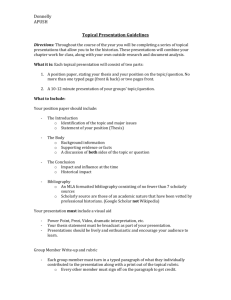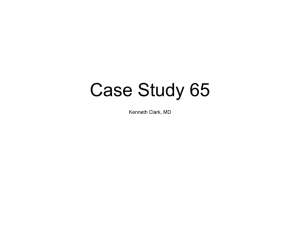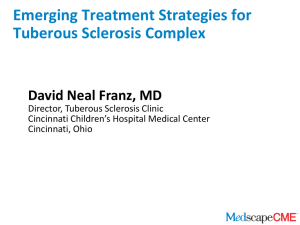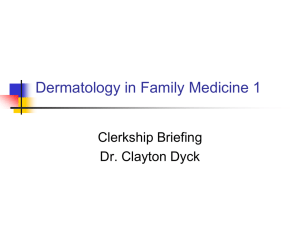Topical Rapamycin Letter of Medical Necessity
advertisement
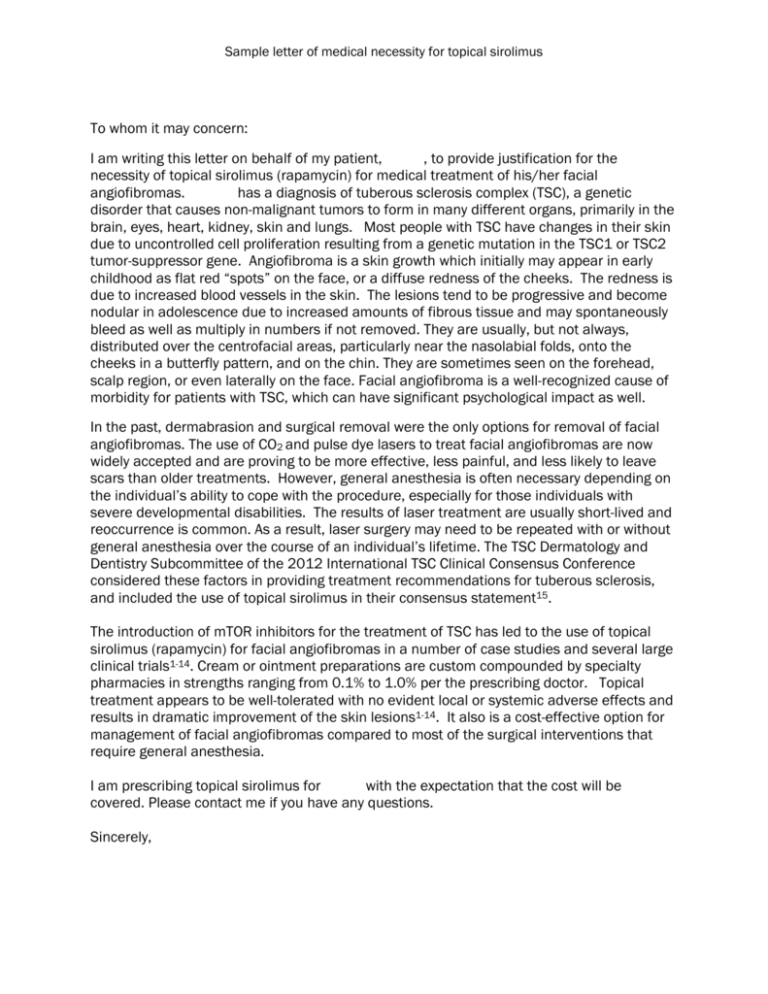
Sample letter of medical necessity for topical sirolimus To whom it may concern: I am writing this letter on behalf of my patient, , to provide justification for the necessity of topical sirolimus (rapamycin) for medical treatment of his/her facial angiofibromas. has a diagnosis of tuberous sclerosis complex (TSC), a genetic disorder that causes non-malignant tumors to form in many different organs, primarily in the brain, eyes, heart, kidney, skin and lungs. Most people with TSC have changes in their skin due to uncontrolled cell proliferation resulting from a genetic mutation in the TSC1 or TSC2 tumor-suppressor gene. Angiofibroma is a skin growth which initially may appear in early childhood as flat red “spots” on the face, or a diffuse redness of the cheeks. The redness is due to increased blood vessels in the skin. The lesions tend to be progressive and become nodular in adolescence due to increased amounts of fibrous tissue and may spontaneously bleed as well as multiply in numbers if not removed. They are usually, but not always, distributed over the centrofacial areas, particularly near the nasolabial folds, onto the cheeks in a butterfly pattern, and on the chin. They are sometimes seen on the forehead, scalp region, or even laterally on the face. Facial angiofibroma is a well-recognized cause of morbidity for patients with TSC, which can have significant psychological impact as well. In the past, dermabrasion and surgical removal were the only options for removal of facial angiofibromas. The use of CO2 and pulse dye lasers to treat facial angiofibromas are now widely accepted and are proving to be more effective, less painful, and less likely to leave scars than older treatments. However, general anesthesia is often necessary depending on the individual’s ability to cope with the procedure, especially for those individuals with severe developmental disabilities. The results of laser treatment are usually short-lived and reoccurrence is common. As a result, laser surgery may need to be repeated with or without general anesthesia over the course of an individual’s lifetime. The TSC Dermatology and Dentistry Subcommittee of the 2012 International TSC Clinical Consensus Conference considered these factors in providing treatment recommendations for tuberous sclerosis, and included the use of topical sirolimus in their consensus statement15. The introduction of mTOR inhibitors for the treatment of TSC has led to the use of topical sirolimus (rapamycin) for facial angiofibromas in a number of case studies and several large clinical trials1-14. Cream or ointment preparations are custom compounded by specialty pharmacies in strengths ranging from 0.1% to 1.0% per the prescribing doctor. Topical treatment appears to be well-tolerated with no evident local or systemic adverse effects and results in dramatic improvement of the skin lesions1-14. It also is a cost-effective option for management of facial angiofibromas compared to most of the surgical interventions that require general anesthesia. I am prescribing topical sirolimus for with the expectation that the cost will be covered. Please contact me if you have any questions. Sincerely, Sample letter of medical necessity for topical sirolimus References 1. Haemel AK, O'Brian AL, Teng JM. Topical rapamycin: a novel approach to facial angiofibromas in tuberous sclerosis. Arch Dermatol. 2010;146(7):715-718. 2. Kaufman McNamara E, Curtis AR, Fleischer AB, Jr. Successful treatment of angiofibromata of tuberous sclerosis complex with rapamycin. The Journal of dermatological treatment. 2012;23(1):46-48. 3. Wataya-Kaneda M, Tanaka M, Nakamura A, Matsumoto S, Katayama I. A topical combination of rapamycin and tacrolimus for the treatment of angiofibroma due to tuberous sclerosis complex (TSC): a pilot study of nine Japanese patients with TSC of different disease severity. Br J Dermatol. 2011;165(4):912-916. 4. Mutizwa MM, Berk DR, Anadkat MJ. Treatment of facial angiofibromas with topical application of oral rapamycin solution (1mgmL(-1) ) in two patients with tuberous sclerosis. Br J Dermatol. 2011;165(4):922-923. 5. Salido R, Garnacho-Saucedo G, Cuevas-Asencio I, et al. Sustained clinical effectiveness and favorable safety profile of topical sirolimus for tuberous sclerosis - associated facial angiofibroma. J Eur Acad Dermatol Venereol. 2012;26(10):1315-1318. 6. DeKlotz CM, Ogram AE, Singh S, Dronavalli S, MacGregor JL. Dramatic improvement of facial angiofibromas in tuberous sclerosis with topical rapamycin: optimizing a treatment protocol. Arch Dermatol. 2011;147(9):1116-1117. 7. Truchuelo T, Diaz-Ley B, Rios L, Alcantara J, Jaen P. Facial angiofibromas treated with topical rapamycin: an excellent choice with fast response. Dermatol Online J. 2012;18(1):15. 8. Foster RS, Bint LJ, Halbert AR. Topical 0.1% rapamycin for angiofibromas in paediatric patients with tuberous sclerosis: a pilot study of four patients. Australas J Dermatol. 2012;53(1):52-56. 9. Koenig MK, Hebert AA, Roberson J, et al. Topical rapamycin therapy to alleviate the cutaneous manifestations of tuberous sclerosis complex: a double-blind, randomized, controlled trial to evaluate the safety and efficacy of topically applied rapamycin. Drugs in R&D. 2012;12(3):121-126. 10. Madke B. Topical rapamycin (sirolimus) for facial angiofibromas. Indian Dermatol Online J. 2013 Jan; 4(1): 54-7. 11. Wheless JW, Almoazen H. A novel topical rapamycin cream for the treatment of facial angiofibromas in tuberous sclerosis complex. J Child Neurol 2013 Jul; 28 (7):933-6. 12. Tanaka M, Wataya-Kaneda M, Nakamura A, Matsumoto S, Katayama I. First left-right comparative study of topical rapamycin vs. vehicle for facial angiofibromas in patients with tuberous sclerosis complex. Br J Dermatol 2013 Dec; 169(6): 1314-8. 13. Knöpfel N, Martin-Santiago A, Bauza A, Hervás JA. Topical 0.2% rapamycin to treat facial angiofibromas and hypomelanotic macules in tuberous sclerosis. Actas Dermosifiliogr 2013 Dec 16 [e-pub ahead of print] 14. Tu J, Foster RS, Bint LJ, Halbert AR. Topical rapamycin for angiofibromas in paediatric patients with tuberous sclerosis: follow-up of a pilot study and promising future directions. Australas J Dermatol 2014 Feb; 55(1):63-9. 15. Teng JMC, Cowen EW, Wataya-Kaneda M, Gosnell ES, Witman PM, Hebert AA, Mlynarczyk G, Soltani K, Darling TN. Dermatologic and dental aspects of the 2012 international tuberous sclerosis complex consensus statements. JAMA Dermatol. 2014 Jul 16 [e-pub ahead of print].

